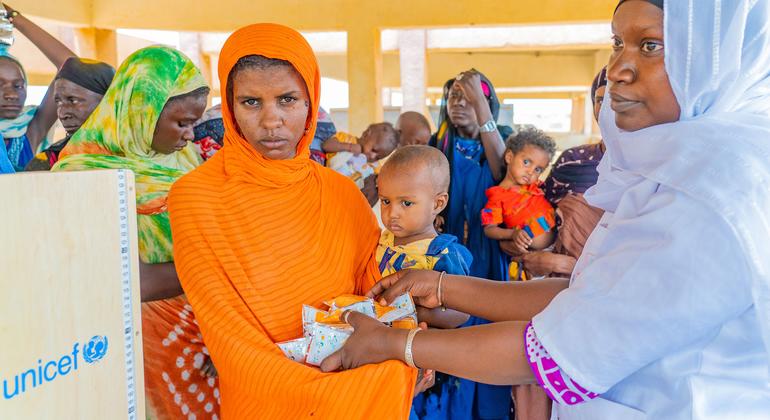|
Getting your Trinity Audio player ready...
|
“The bottom line is that we are still far off-track towards the goal of ridding the world of hunger, food insecurity and malnutrition by 2030,” said Maximo Torero, Chief Economist at the UN Food and Agriculture Organization (FAO), in reference to the Sustainable Development Goals (SDGs) and specifically SDG 2: Zero Hunger.
Mr. Torero noted that if current trends persist, around 582 million people will still face hunger in 2030, half of them in Africa.
Despite progress in combating stunting and in promoting breastfeeding, global hunger levels have remained stubbornly static for three consecutive years.
Between 713 million and 757 million people were undernourished in 2023, around 152 million more than in 2019, according to the report, a joint publication by FAO, the International Fund for Agricultural Development (IFAD), the UN Children’s Fund (UNICEF), the UN World Food Programme (WFP), and the UN World Health Organization (WHO).
Africa, Asia, Latin America in focus
Regional trends show a stark contrast with hunger continuing to rise in Africa, affecting 20.4 per cent of the population, while remaining stable in Asia at 8.1 per cent. This is a significant concern given that the region houses more than half of those facing hunger worldwide. Latin America has shown some progress with 6.2 per cent of its population facing hunger. However, from 2022 to 2023, hunger increased in Western Asia, the Caribbean, and most African subregions.
FAO’s Mr. Torero highlighted that Africa faces a unique challenge as it is the only region where hunger has risen owing to all three major drivers: conflict, climate extremes and economic downturns.
Of them all, he emphasized that war remains “a major driver” of hunger, exacerbating the food crisis across countries.
Getting enough food is out of reach
The report’s other key findings include that access to adequate food remains out of reach for billions. In 2023, approximately 2.33 billion people globally were moderately or severely food insecure, almost the same number as during the COVID pandemic.
Over 864 million people experienced severe food insecurity, meaning having to go for periods without food. While Latin America has seen some improvement in food security, in Africa, a full 58 per cent of the continent’s people are moderately or severely food insecure.
The economic reasons for global remain a major issue, too: the report found 2.8 billion people couldn’t afford a healthy diet in 2022. The contrast between high-income and low-income countries is stark, with just 6.3 per cent of people in the former unable to afford a healthy diet, compared to 71.5 per cent in poorer nations. And although Asia, North America and Europe saw improvements, the situation worsened in Africa.
Coronavirus link to hunger
COVID-19 remains a significant marker in the fight against global hunger, with the number of people unable to afford a healthy diet by 2022 falling below pre-pandemic levels in upper-middle and higher-income countries.
On the other hand, in low-income countries by 2022, the number of people unable to buy enough healthy food reached its highest level since 2017. In 2020, 1.68 billion people globally could not afford a healthy diet, with a 59 per cent increase in lower-middle-income countries. Mr. Torero attributed this disparity to “the significant increase of inequalities among countries and regions caused by COVID-19”.
Targets hit – and missed
Progress in child nutrition has been mixed, the UN report shows.
Although exclusive breastfeeding rates have increased to 48 per cent, low birthweight levels remain stagnant at around 15 per cent and stunting in children under five decreased to 22.3 per cent – still short of targets.
There was little movement in combating wasting and anaemia in women, while adult obesity continued to rise, reaching 15.8 per cent in 2022, with projections of more than 1.2 billion obese adults by 2030.
These numbers show the complexity of malnutrition in all its forms and the need for targeted interventions, the report’s authors maintained, amid a backdrop of persistent food price inflation, conflicts, climate change and economic downturns that is making food insecurity and malnutrition worse globally.
Digging deep to end hunger
In line with the theme of this year’s report – “Financing to End Hunger, Food Insecurity and All Forms of Malnutrition” – its recommendations focus on a comprehensive approach to achieving SDG 2: Zero Hunger. This includes transforming agrifood systems, addressing inequalities and making healthy diets affordable and accessible.
The report calls for increased, cost-effective financing and a standardised approach to food security and nutrition.
Mr. Torero explained: “One of the major recommendations is to come up with a common definition so that we understand what we are financing and the key elements to include in this definition. This will enhance accountability for donors and provide a clearer picture of financial flows.”
UN agency heads, including FAO Director-General Qu Dongyu and UN Children’s Fund (UNICEF) Executive Director Catherine Russell, stressed that closing the financing gap is crucial. They emphasized that substantial investment is required to end hunger and malnutrition, framing it as both a future investment and a fundamental obligation.
Of the 119 low and middle-income countries featured in the report, 63 per cent have limited access to financing. These countries are also affected by multiple factors of food insecurity. Better data coordination, higher risk tolerance and more transparency are key to bridging the financing gap and strengthening global food security efforts, the report maintains.
“We need to understand that our agri-food systems are under increasing risk and uncertainty due to climate change…donors must adopt greater risk tolerance to activate effective finance,” Mr. Torero said.



